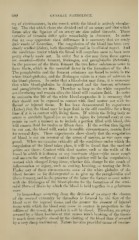Page 670 - My FlipBook
P. 670
G80 GENERAL PATHOLOGY.
ety of circumstances, in the vessels while tlie blood is actively circulat-
ing. The clot which closes the divided end of an artery and that which
forms after the ligation of an artery are also called thrombi. These
varieties of thrombi differ quite remarkably in character. In order
that we may appreciate these differences it is necessary that we study
their mode of formation. The coagulation of the blood has been very
closely studied (Zahn), both theoretically and in its clinical aspect. And
the conditions under which the blood will coagulate seem to have been
pretty clearly made out. In order that a clot may form three agents
are essential—fibrin ferment, fibrinogen, and paraglobulin (kSchmidt).
In the presence of the fibrin ferment the two latter substances unite to
form fibrin, which is the essential factor in the formation of the clot.
The paraglobulin and the ferment substance are found to reside in the
white blood-globules, and the fibrinogen exists in a state of solution in
the blood-plasma. In order that a blood-clot may form, it is necessary
that white blood-globules be disintegrated and the ferment substance
and paraglobulin set free. Therefore as long as the white corpuscles
are circulating and remain alive the blood will continue fluid. In order
to maintain the life of the ^^liite blood-corpuscles it is necessary that
they should not be exposed to contact with dead matter nor with in-
flamed or injured tissue. It has been demonstrated by experiment
(Lister) that the blood may be kept fluid in the still condition for a long
time if it is in contact with living tissue. If within the living body an
artery is carefully ligaied (so as not to injure its internal coat) at two
j)oints in such a manner as to include a portion filled with blood, this
will remain fluid for twelve or fifteen days. If the section thus ligated
be cut out, the blood will, under favorable circumstances, remain fluid
for several days. These experiments show clearly that the coagulation
of blood is not on account of the arrest of motion, as was once sup-
posed. When we examine critically all the conditions under which the
coagulation of the blood takes place, it will be found that the cardinal
points are these : Contact with dead matter, such as the walls of the
vessel in which it is drawn or any inanimate object — (the more rough
and uneven the surface of contact the quicker will be the coagulation),
contact with chrnu/ed living tissue, whether this change be the result of
inflammation or injury, such as cutting, bruising, or tearing the flesh.
Under any of these circumstances some of the white globides of the
blood become so far disintegrated as to give up the paraglobulin and
fibrin ferment, and in the presence of the latter the former at once unites
with the fibrinogen of the blood-plasma for the formation of the semi-
solid fibres of fibrin by which the blood is held together in a gelatinous
mass.
In hemorrhage occurring from the division of an artery the closure
of the severed extremity by thrombus is favored by the flow of the
blood over the injured tissue, and the greater the amount of injured
tissue with which the blood may come in contact in proportion to the
calibre of the vessel, the quicker it will be closed. Therefore, an artery
severed by a blunt instrument that causes much bruising of the tissues
is much nioi'e readily closed l)v the clotting of the blood than if severed
by a very sharp instrument. Nature has also provided means of increas-


